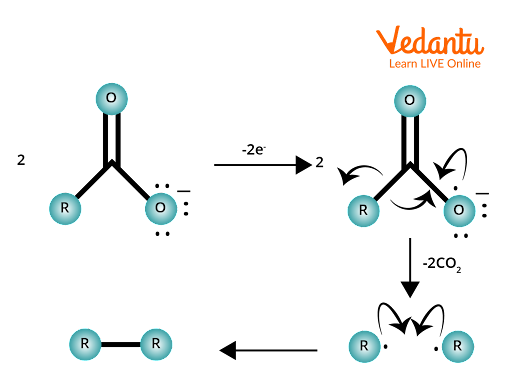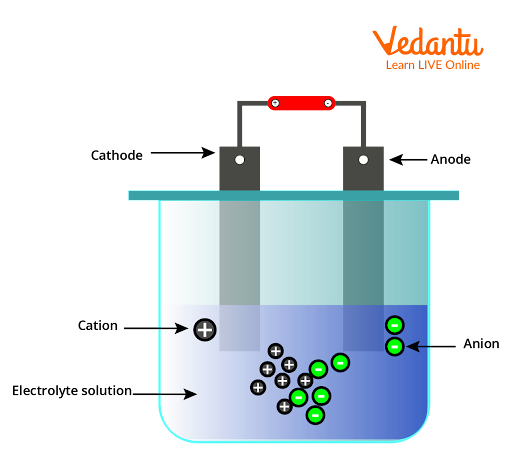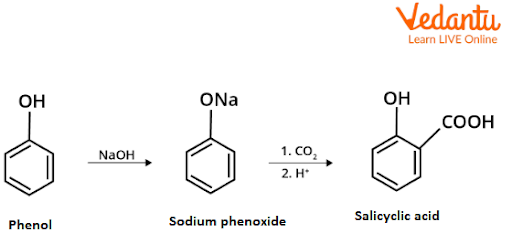




Complete Explanation of Kolbe's Electrolysis Method - Preparation of Alkanes
Kolbe's Electrolytic Method is an interesting and important topic in organic chemistry, often featured in JEE Main exams. It explains how carboxylic acid salts undergo electrolysis to form alkanes through decarboxylation. This process not only strengthens your understanding of reaction mechanisms but also highlights its practical applications in organic synthesis. This article aims to simplify Kolbe’s Electrolytic Method for students preparing for JEE Main 2025. With easy-to-follow explanations and relatable examples, we’ve explained the concept to help you grasp this topic better.
What is Kolbe's Electrolytic Method?
Kolbe electrolysis, sometimes known as the Kolbe reaction, is a type of organic reaction named after Hermann Kolbe. It's best for making symmetrical dimers, but it can also be used to make unsymmetrical dimers when combined with a mixture of two carboxylic acids.
The Kolbe reaction is a decarboxylative dimerisation of two carboxylic acids in its formal form (or carboxylate ions). The general reaction is

General Reaction of Kolbe's Electrolysis
Mechanism of the Above Reaction:
Two molecules of carboxylate ions lose two electrons and two molecules of carbon dioxide to form two alkyl free radicals, which then join together to form an alkane.

Electrolysis
Let us now define electrolysis. The word "lysis" means "to separate or break," so electrolysis would be defined as "electric breakdown." Electrolysis is a method of causing a non-spontaneous chemical reaction to occur using electrical energy.
Electrolysis is a chemical and industrial process that uses the direct electric current (DC) to drive a chemical reaction that would otherwise be non-spontaneous. The use of an electrolytic cell in the commercial separation of elements from naturally occurring sources such as ores is important. The decomposition potential is the voltage needed for electrolysis.

The Process of Electrolysis
Faraday’s Law of Electrolysis
The amount of product created by the passage of an electric current (moles) is stoichiometrically equal to the quantity of electrons provided (moles).
The stoichiometry of the reaction, the size of the current flowing, and the time during which the current flows are used to compute the amount of product generated during an electrolysis operation.
Kolbe's Reaction
Let us now explain Kolbe's reaction. It is sometimes known as the Kolbe-Schmitt reaction, after Hermann Kolbe and Rudolf Schmitt, and is an addition reaction. The phenoxide ion is formed when phenol reacts with sodium hydroxide. The phenoxide ion generated in electrophilic aromatic substitution processes is more reactive than phenol. As a result, the weak electrophile carbon dioxide undergoes an electrophilic substitution process. Ortho-hydroxybenzoic acid is the main product (salicylic acid). Kolbe's reaction is another name for this process.

Kolbe's Reaction to Preparation of Alkane
Electrolysis is the process of electrolysing a concentrated sodium salt of a carboxylic acid. In one of the products, the alkane is produced at the anode. This reaction of the formation of alkane from a derivative of the carboxylic acid is also known as Kolbe’s reaction.

Kolbe Electrolysis Mechanism
Kolbe electrolysis reaction has the following mechanism:
The sodium salt of carboxylic acid undergoes electrolysis to form alkane as the major product and carbon dioxide water and caustic soda as byproducts.
An oxidation reaction occurs at the anode, which results in the loss of carbon dioxide and the formation of two methyl free radicals which then react among themselves forming ethane.
Reduction occurs at the anode which results in the formation of two hydroxide ions as well as two hydrogen free radicals which react among themselves, forming hydrogen molecules.

Mechanism of Kolbe’s electrolysis.
Synthesis of Acetic Acid by Kolbe
For the first time in 1845, German chemist Hermann Kolbe produced or synthesised acetic acid from inorganic components. He combined chlorine and carbon disulfide to produce carbon tetrachloride. The electrolytic reduction to acetic acid was then followed by heat decomposition to tetrachloroethylene and aqueous chlorination to trichloroacetic acid. Only hydrocarbons were employed in the inorganic chemicals he used. As a result, Kolbe was the first to make acetic acid from carbon, hydrogen, and oxygen.

Limitations of Kolbe's Electrolytic Method
Restricted to Carboxylic Acids: Only works effectively with carboxylic acid salts, limiting its application to specific compounds.
Low Yield of Alkanes: The method often produces low yields of alkanes due to side reactions such as the formation of oxygen at the anode.
Side Product Formation: Secondary products like carbon dioxide and hydrogen gas can form during the reaction, reducing efficiency.
Complex Mixture of Products: For alkanes with longer chains, the reaction may produce a mixture of products, complicating separation and purification.
Energy Intensive: The electrolysis process requires a significant amount of electricity, making it less cost-effective for large-scale synthesis.
Unsuitable for Aromatic Compounds: Aromatic carboxylic acids are not efficiently converted to desired hydrocarbons, limiting their scope in organic synthesis.
Tips for Preparations Kolbe's Electrolytic Method :
Understand how decarboxylation leads to alkane formation.
Focus on the general reaction: RCOONa → R-R + CO₂ + NaOH.
Know what happens at the anode (oxidation) and cathode.
Solve reactions with different carboxylic acids.
Learn about side products and yield issues.
Know practical uses and industrial relevance.
Practice previous year's questions and mock tests for confidence.
Conclusion
At the anode of Kolbe's electrolytic method, the electrolysis of an aqueous solution of a potassium or sodium salt of a carboxylic acid produces an alkane with an even number of carbon atoms. The decarboxylation of the sodium salt of fatty acid occurs in this reaction. A two-stage radical process is involved in the reaction mechanism, namely, electrochemical decarboxylation produces a radical intermediate, which combines to form a covalent bond. This reaction is used in the formation of alkanes and acetic acid from carboxylic acid derivatives, which undergoes an electrolytic mechanism.
JEE Main 2025 Subject-Wise Important Chapters
The JEE Main 2025 subject-wise important chapters provide a focused strategy for Chemistry, Physics, and Maths. These chapters help students prioritise their preparation, ensuring they cover high-weightage topics for better performance in the exam.
Check Other Important Links for JEE Main 2025
JEE 2025 needs well-structured study materials. Here are some valuable resources to help you plan your preparation and practice efficiently.
FAQs on Kolbe's Electrolytic Method for JEE Main 2025
1. What are the importance and limitations of the Kolbe reaction?
The Importance of Kolbe’s Reaction is as Follows:
For the manufacture of 3-hydroxy-2-naphthoic acid, Kolbe's process is utilised. This acid is a common precursor to azo dyes and pigments. Salicylic acid is combined with acetic anhydride, which is obtained through Kolbe's reaction. Aspirin is a common pain reliever.
The Limitations of Kolbe’s Reaction are as Follows-
Alkanes with an even number of carbon atoms are the only ones that can be made through Kolbe’s reaction.
We cannot produce methane by this process.
2. a) Which ortho product is produced in the Kolbe reaction?
b) Which electrophile is used and how does it operate as an electrophile?
Kolbe's reaction has the following Mechanism:
The negative charge develops in the ortho position as a result of the aforesaid procedure. As a result, the electrophilic substitution occurs at the ortho position, yielding ortho hydroxybenzoic acid as a product.

b) Carbon dioxide is the electrophile in Kolbe's process. This is due to the fact that the phenoxide ion is more reactive toward the electrophilic aromatic substitution process than the phenol ion. The molecule undergoes a substitution reaction with carbon dioxide because it is a poor electrophile.
3. What are the factors that affect the electrolysis process?
Electrolysis is Additionally Influenced by Factors such as:
The Electrolyte's Nature and Condition- The electrolyte should be in a liquid state, molten or in a solution with a suitable polar solvent for electrolysis.
The Nature and Electrode Potential of Electrolyte's Ions- The electrolysis of two elemental ions in electrolytes is straightforward, yielding the two elements on electrolysis.
The Electrode's Nature- The nature of the electrolyte can result in diverse products for the same electrolyte.
An Excessive Amount of Voltage at Electrodes- The electrolytic processes and products are determined by the redox potential of electrolyte ions. During electrolysis, the redox potentials of some half-reactions can sometimes exceed the thermodynamic potentials. The voltage of the half-excess reaction (over-voltage) may be unfavourable to the reaction and alter the electrolysis result.
4. What is Kolbe's Electrolytic Method?
Kolbe's Electrolytic Method involves the electrolysis of carboxylic acid salts to produce alkanes. Vedantu’s FREE PDF for JEE Main 2025 simplifies this topic with examples.
5. How does Kolbe's electrolytic method work?
In the Kolbes electrolytic method, carboxylic acid salts undergo electrolysis, releasing CO₂ and forming alkanes.
6. What is Kolbe's electrolysis?
Kolbe's electrolysis refers to the electrochemical reaction where carboxylic acids are decarboxylated to form hydrocarbons. Vedantu’s JEE resources make this concept easy to grasp.
7. What is Kolbe's reaction mechanism?
Kolbe's reaction mechanism involves the oxidation of carboxylic acids at the anode to form free radicals, which combine to form alkanes.
8. What is Kolbe's synthesis of alkane?
Kolbe synthesis of alkane uses the electrolysis of carboxylic acid salts to produce alkanes.
9. What is Kolbe's electrolysis reaction?
Kolbe's electrolysis reaction describes the decarboxylation of carboxylic acid salts during electrolysis to form hydrocarbons. Vedantu offers practice questions for JEE Main 2025.
10. What is the electrophile used in the Kolbe reaction?
The electrophile used in the Kolbe reaction is the free radical formed during the oxidation of carboxylic acids.
11. What is Kolbe electrolysis reagent?
The Kolbe electrolysis reagent typically includes the salt of a carboxylic acid, such as sodium acetate, for electrolysis.
12. What is Kolbe's electrolytic decarboxylation?
Kolbe's electrolytic decarboxylation is the removal of a carboxyl group from carboxylic acid salts during electrolysis, producing alkanes.
13. How important is Kolbe's electrolytic method for JEE Main?
Kolbe's electrolytic method is a key topic in organic chemistry, often appearing in JEE Main. Vedantu provides comprehensive resources to master it for the 2025 exams.












